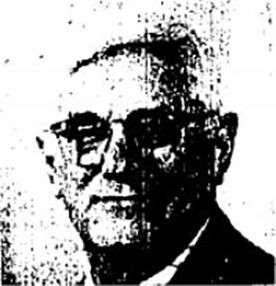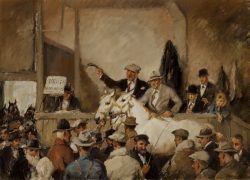Walter Krawiec, from a photograph reproduced in Chicago Tribune, Nov. 2, 1947.

Walter Krawiec 1889–1982
Brought to the U.S. as a small child from the rural village of Morzewo, Poland, Walter Krawiec was inspired to become an artist through his early love of horses. During his boyhood in Chicago, he haunted a neighborhood stable and a hook-and-ladder company to admire and sketch the animals. In his teens, Krawiec worked for a manufacturer of airbrushes before enrolling in night classes at the Art Institute of Chicago. In 1914 he began a six-decade-long career as an editorial cartoonist for the Polish Daily News; later he also illustrated the Catholic journal The New World. While drawing daily cartoons, Krawiec returned to the Art Institute in earnest, studying under portraitist Ralph Clarkson among others and earning a Ryerson Traveling Fellowship. At the school he met his future wife, painter Harriet Korzeniewsky (Harriet B. Krawiec), who specialized in floral images.
Krawiec began showing his paintings at the Art Institute in its annual “Chicago and Vicinity” exhibition of 1927, winning a prize that year. In 1929 he was included in the world’s fair art exhibition in Poznan, Poland, where he was awarded a silver medal. Endowed with “a newspaper man’s eager sense for the significant and the spectacular,” according to critic Clarence J. Bulliet, Krawiec was a popular and widely exhibited painter throughout the 1930s and 1940s.i Known particularly for his lively scenes of circuses, racetracks, and polo matches in which horses figure prominently, he also painted bucolic midwestern landscapes, industrial scenes, and portraits. Loosely brushed and brightly tinted, his oils and watercolors show typical character types ranging from well-heeled racing spectators to circus performers.
In 1935 a well-received Art Institute exhibition shared by Krawiec and his wife focused on his circus images. He also had solo shows at the Chicago Galleries Association and he participated in numerous group exhibitions in local and national venues, including the National Academy of Design in New York, the Carnegie International in Pittsburgh, and the Corcoran Gallery of Art in Washington, D.C., as well as the 1933 and 1934 art exhibitions associated with Chicago’s Century of Progress Exposition. In the 1938 show organized in Chicago by the conservative Society for Sanity in Art, his works won praise for their “strong moral fiber.”ii Krawiec continued to paint into the late 1940s, exhibiting particularly at the Chicago Galleries Association, an organization sympathetic to many Chicago artists sidelined in a changing art world. His paintings, as Chicago Tribune writer Edith Weigle observed, “portray a wholesome, good-homemade-bread sort of world, an uncomplicated place . . . where the horse is man’s best friend, and man himself is simple, honest, and pre-Freudian.”iii
Wendy Greenhouse, PhD
i C. J. Bulliet, “Around the Galleries,” Chicago Daily News, July 21, 1935.
ii Eleanor Jewett, “Moral Vacuity Marks Current One Man Shows,” Chicago Tribune, July 28, 1935.
iii Edith Weigle, “Paintings by Another Chicagoan,” Chicago Tribune, Nov. 2, 1947.
